Apple Watch vs Samsung Gear S
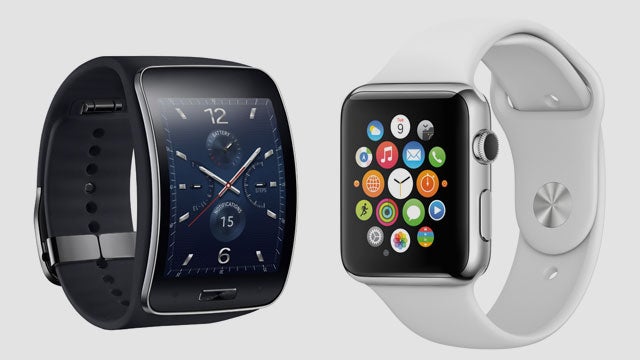
Apple vs Samsung: Let smartwatch battle commence…
It wouldn’t be an Apple product without its Samsung equivalent. Currently on its fifth smartwatch in just under a year, Samsung hasn’t really done a fantastic job of convincing us that it holds the key to giving smartwatches appeal.
The new Gear S, which costs £269.99, arrives just in time to fight it out with the Apple Watch for a place on your wrist. Is there a clear winner in the race to build the must-have smartwatch?
We see how the two smart timepieces match up.
Apple Watch vs Samsung Gear S: Design
Apple Watch: Aluminium, stainless steel and 18-karat gold, 38mm and 42mm sizes, six interchangeable straps
Samsung Gear S: Plastic, white and black watch straps, 12.5 mm thick, Water resistant
Samsung’s smartwatches up until the Gear S have all adopted the same rectangular watch face with an evenly sized black bezel. So it’s not an edge-to-edge display like the Moto 360. What’s more noticeable is the much larger wrap around watch strap, people are really going to notice. There’s nothing really discreet about it at all. The watch straps can be replaced and if you want to glitz things up, Samsung is offering a Swarvoski crystal-encrusted edition and a Black Gold version with fashion designer Diesel.
Unlike most smartwatch manufacturers, including Samsung, Apple is offering its watch in two sizes and with a variety of styles to appeal to both men and women. There’s also a host of different straps including a more durable sport band and a suit-friendly link bracelet. Apple is certainly offering more variety and flexibility to customize its smart watch, but both clearly have strong, distinctive looks.
Apple Watch vs Samsung Gear S:Screen
Apple Watch: 1.5 inches and 1.65 inch Retina display, Sapphire and Ion-X glass
Samsung Gear S: 2-inch curved Super AMOLED screen, 360 x 480, 300ppi, Gorilla Glass 3
Samsung’s smartwatch displays have impressed in the past so it’s no surprise to see that it’s sticking with the same technology. The Gear S does include a larger screen than the Apple Watch and it’s curved, continuing the trend that first started with the Gear Fit. There’s a bump up in resolution as well so you can expect a sharp, vibrant screen on which to view apps and notifications. Although, as we found out with the Gear Fit, the curved design doesn’t always deliver great viewing outdoors in bright sunlight.
Apple is using a ‘Retina’ display although at the moment, that doesn’t mean a whole lot because we have no idea of the precise screen resolution. We do know that the Apple Watch won’t have an always on mode and will be reinforced with the Sapphire glass many tipped the iPhone 6 to include.
The Apple Watch Sport edition also uses ‘strengthened Ion-X glass’, which aims to offer protection while keeping the overall weight of the smartwatch down to make it more comfortable to wear when training or working out. Apple is also using something it’s calling Force Touch, which means the screen can tell the difference between presses and taps. Quite how well it’s going to be able to distinguish between the two, we are not entirely convinced.
SEE ALSO: Apple Watch vs Android Wear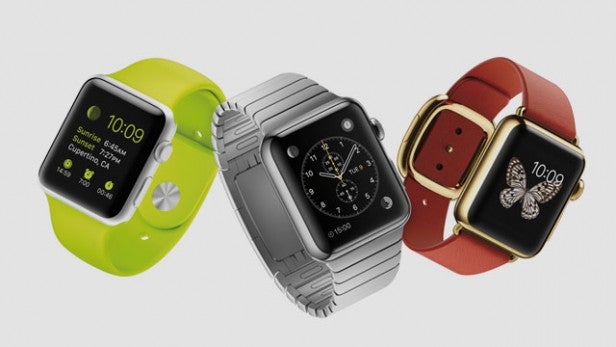
Apple Watch vs Samsung Gear S: Software and Apps
Apple Watch: Custom operating system
Samsung Gear S: Tizen OS
Despite going Android Wear for the Gear Live, the Gear S reverts back to Samsung’s own Tizen operating system. In our experience with it on previous Samsung Gear watches, core features like notifications, music control and using third-party applications work well and the UI is easy to get around.
Samsung swaps Google’s Voice Search for S Voice and there’s even an on-screen keyboard if you want to attempt to respond to an email on a tiny screen. One of the biggest problems with Tizen currently is app support. Facebook and Nike are the latest big name recruits but the jury is still out on whether there’s an appetite to develop for the platform.
Apple is taking an entirely new approach in using a custom operating system for its range of smartwatches. It’s still largely based on bringing phone notifications to your watch and it will only work with iPhones. What we know about the user interface so far is that there will be at least one homescreen where all apps appear to live.
Gestures are not as important as they are on Android Wear and that’s down to the ‘Digital Crown’. The physical watch dial can be used to scroll, zoom and select content on the touchscreen display. There’s also Siri support if you do want to talk to your wrist and Digital Plus communication service activated via a button below the Crown. A ‘taptic engine’, which is essentially a more sophisticated version of haptic feedback, can send vibrations to your wrist when you receive alerts or even point you in the right direction when using Maps.
For apps, Apple is hoping developers will take full advantage of its WatchKit developer platform. Some of the potential uses with the Apple Watch were demonstrated, like the ability to use it to board planes or even unlock hotel room. We can also expect applications for viewing photos using maps for navigation. Apple has already announced partnerships with Facebook, Twitter, Pinterest and even BMW to make Apple Watch apps, so there’s plenty to suggest the App Store will be well stocked ahead of next year’s launch.
SEE ALSO: iPhone 6 vs iPhone 6 Plus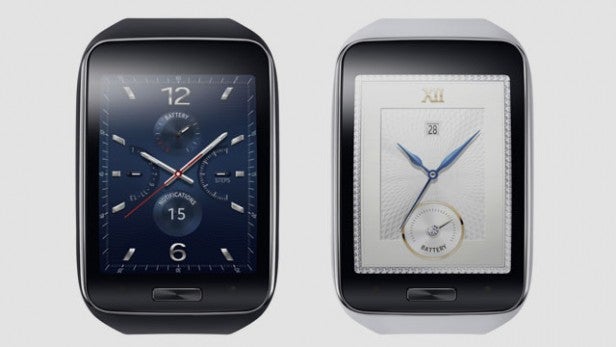
Apple Watch vs Samsung Gear S: Power
Apple Watch: Custom S1 processor
Samsung Gear S: 4GB storage, 512MB RAM, Dual-core 1.0 GHz
For power, the Gear S doesn’t veer too far away from what we’ve already seen in previous Samsung smartwatches. There’s a dual-core 1GHz processor along with 512MB of RAM to help keep things zippy. The 4GB of storage means there’s some capacity to store content as well.
For the Apple Watch, it’s venturing into the unknown at the moment. All we know so far is that all the power the Apple Watch needs will fit onto a single chip. We don’t know how much RAM will accompany the S1 processor or even how much storage, if any, will be available to save content like apps. We don’t imagine it will too drastically different from what’s already available although with all of the features Apple has spoken about, it’s going to have to be something pretty special.
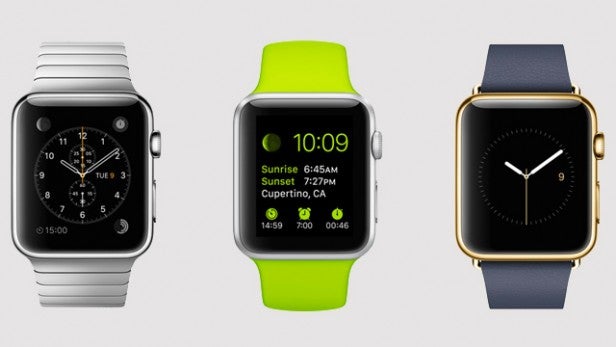
Apple Watch vs Samsung Gear S: Battery
Apple Watch: TBC, wireless charging support
Samsung Gear S: 300mAh battery, internal battery
This is inevitably where all smartwatches are failing at the moment. The Gear S is only equipped to run for a maximum two days, which is at least better than the one day for the Moto 360. Samsung is still using its proprietary charging cradle so there’s no wireless charging support, but it does now include an internal battery, which can deliver 50 per cent of power to keep you running a little longer.
Apple hasn’t said a word about battery life and that’s worrying. This leads us to think it’s not going to be any better than smartwatches like the Gear S for staying power.
Apple Watch vs Samsung Gear S: Connectivity
Apple Watch: Bluetooth, NFC
Samsung Gear S: 2G and 3G, Bluetooth, GPS
The Gear S still uses Bluetooth to sync up with compatible Samsung Android phones, but the addition of GPS and a built-in SIM card slot means your smartwatch powers are not limited when you don’t have your phone. Having GPS switched on for long periods, though, is not going to be great for that 2-day battery life, while carrying two SIM cards is going to be expensive.
Apple similarly uses Bluetooth to connect to your iPhone and can harness GPS and Wi-Fi data from your Apple smartphone to add extra functionality. There’s no 3G or GPS support, but it will integrate NFC to support Apple Pay, the company’s new mobile payment service. So, you might not be able to walk around with it sans phone but you will be able to buy your shopping if you’ve forgotten your wallet.
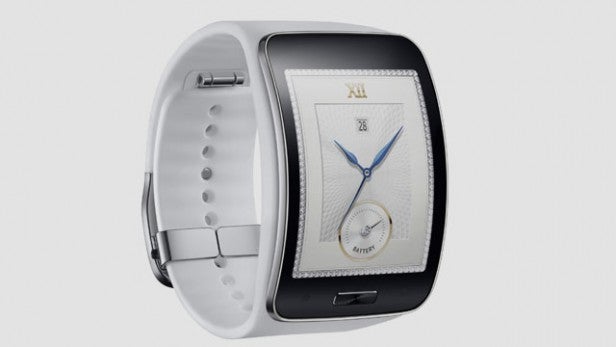
Apple Watch vs Samsung Gear S: Extra Features
Apple Watch: Heart rate monitor, accelerometer, Passbook
Samsung Gear S: Heart rate monitor, accelerometer, gyroscope, compass, barometer, ambient light sensor
Samsung has been making a big push with its S Health platform so there’s no surprise to see the same with the Gear S. Alongside a pedometer, there’s also a built-in heart rate monitor for tracking how hard you are working in the gym or struggling up a flight of stairs. Sleep tracking is also supported, but this has to be done manually. Elsewhere, there’s a UV monitor to keep you safe in the sun and there’s no camera for taking rubbish stealth-style photos.
The Apple Watch is not short of extras either. It also includes a heart rate sensor, albeit a slightly similar setup with an accelrometer used to help produce more accurate readings when you are on the move. It’s also introducing Workout and Activity apps to help keep you motivated by creating goals and sending reminders to make sure you don’t forget about going for that run after work. Alongside Apple Pay, there’s also Passbook support so you can store tickets and boarding passes and not worry about leaving them behind.
Early Verdict
Samsung’s fifth smartwatch is the most feature-packed yet and goes some way to breaking the reliance on your phone to get the most out of it. Unfortunately, it’s still tied to Samsung’s phones and app support along with the battery life are still major concerns.
The Apple Watch in comparison still leaves many questions about key features unanswered. It’s likely to be more expensive than the Gear S and you will have to wait until next year to buy one. Our hunch is to hold off for now. Judging by the rate the Samsung watches are flying out of the door, there’s probably going to be a new one, that will leave the Gear S looking redundant.
MORE: Apple Watch vs Pebble


